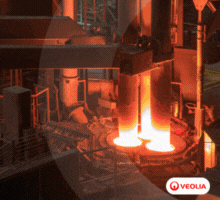2013 World DRI Production Surpasses 75 Million Tons
06/11/2014 - The world’s direct reduction industry grew again in 2013 setting yet another new record for the industry with 75.2 million tons produced, according to data compiled by Midrex Technologies, Inc. and audited by World Steel Dynamics.
This was an increase of two million tons per year, or 2.8% above 2012’s numbers - quite remarkable considering the economic forces that affected the industry. In terms of technology, MIDREX® Plants once again led the production of all DRI products generated with 63%, of the market; this was followed by rotary kilns (largely in India) at 21% and Energiron plants with 15%.
The DRI industry has grown in eight of the past ten years. Output in 2013 was more than 85% greater than in 2001. Factors that have placed a drag on growth in the preceding years continued, but were overshadowed by the demand for direct reduced iron.
Growth and decline detailed – MENA, Russian, India and Venezuela
The primary region of industry growth was the Middle East/North Africa (MENA): MENA grew by an additional five million tons over 2012 numbers; the Kingdom of Bahrain entered the group of DRI producing nations as the SULB’s new 1.5 MPTY MIDREX® Plant began operation; and Iran once again demonstrated major growth, increasing output by nearly three million tons primarily via the ramp-up of a number of recently commissioned modules.
Elsewhere in the region, Saudi Arabia and the United Arab Emirates set new records for national DRI production. Oman increased production slightly for the year and Libya increased tonnage as their industry continues to rebuild from the civil war. Altogether MENA made 32.4 million tons of DRI, which was 55% of the world’s total production of natural gas fueled DRI. Outside of MENA, additional growth was also seen in Russia, which had a new national record production of 5.3 million tons.
World DRI production increased in 2013 despite the fact that two key producing countries, India and Venezuela, saw significant declines in production.
India fell to 17.8 million tons. This was down from the all-time high that India had enjoyed only three years earlier when it made 23.4 million tons in 2010. The main reasons for the decline were the same difficulties that have been seen in the past few years, which included: lower availability of domestic iron ore due to regulations, licensing related to environmental requirements and extremely high prices of natural gas. Regarding the latter problem, a number of companies in India are building facilities to make DRI using syngas produced from coal in place of natural gas. Two of these facilities are expected to be commissioned in 2014. Since 2010, natural gas based DRI production in India is down by more than half. DRI production by rotary kiln modules in India, also declined in 2013 to less than 16 million tons.
Venezuela continued to struggle with DRI production - down 40% from 2012. This meant the country was down to less than one-third of its maximum production in 2005. The immediate reason is a shortage of iron oxide pellets to feed the DR plants, but the underlying reason is lack of funds for maintenance throughout the supply chain; mining, transportation, materials handling, pelletizing, ironmaking and infrastructure.
Forces Affecting the Industry
The ore supply problem in India was the largest factor restricting production. High prices of natural gas and difficulty in acquiring gas were also problems. In contrast, steadily growing demand as the world economy continues to slowly recover from the financial crisis of 2008-2009 helped to further production. Shale gas exploration in the USA and Canada has led to lower natural gas pricing in North America - encouraging the building of new DR capacity. One plant has already begun commercial operation and another project broke ground for construction in April of this year. More facilities are expected to be contracted in the USA over the next few years.
DRI production Forecast
Approximately 16 million tons per year of DRI capacity are currently under construction. A conservative view of the situation is that some of the plants/projects are in locations where it will be difficult to maintain schedules as planned with economic and political factors in these areas possibly slowing completion. Midrex forecasts that those plants currently under construction will come on stream over the next 3 years.
Recent annual DRI production increases have been impacted by the decline in production in India & other areas. Midrex believes that there will be increases of five million tons per year and more over the next decade.
In the USA alone because of shale gas exploration, which has lowered natural gas prices, it is expected that total DRI production will be at least 10 million tons per year by 2020. Nearly half of this increased production capacity has already been built or is in the construction phase. The USA will most likely see to 2-3 more facilities, representing 5-6 million tons of capacity being built in North America by end of this decade.
In areas without access to low cost natural gas, other technologies are being explored and implemented. Already in progress for India are plants using syngas produced from coal instead of natural gas for DRI production. In addition, at least one plant is exploring supplementing its natural gas supply with coke oven gas (COG) to maximize existing resources and lessen dependency on natural gas.
For more complete information on 2013 DRI Production, please visit www.midrex.com to download the 2013 world Direct Reduction Statistics.
The DRI industry has grown in eight of the past ten years. Output in 2013 was more than 85% greater than in 2001. Factors that have placed a drag on growth in the preceding years continued, but were overshadowed by the demand for direct reduced iron.
Growth and decline detailed – MENA, Russian, India and Venezuela
The primary region of industry growth was the Middle East/North Africa (MENA): MENA grew by an additional five million tons over 2012 numbers; the Kingdom of Bahrain entered the group of DRI producing nations as the SULB’s new 1.5 MPTY MIDREX® Plant began operation; and Iran once again demonstrated major growth, increasing output by nearly three million tons primarily via the ramp-up of a number of recently commissioned modules.
Elsewhere in the region, Saudi Arabia and the United Arab Emirates set new records for national DRI production. Oman increased production slightly for the year and Libya increased tonnage as their industry continues to rebuild from the civil war. Altogether MENA made 32.4 million tons of DRI, which was 55% of the world’s total production of natural gas fueled DRI. Outside of MENA, additional growth was also seen in Russia, which had a new national record production of 5.3 million tons.
World DRI production increased in 2013 despite the fact that two key producing countries, India and Venezuela, saw significant declines in production.
India fell to 17.8 million tons. This was down from the all-time high that India had enjoyed only three years earlier when it made 23.4 million tons in 2010. The main reasons for the decline were the same difficulties that have been seen in the past few years, which included: lower availability of domestic iron ore due to regulations, licensing related to environmental requirements and extremely high prices of natural gas. Regarding the latter problem, a number of companies in India are building facilities to make DRI using syngas produced from coal in place of natural gas. Two of these facilities are expected to be commissioned in 2014. Since 2010, natural gas based DRI production in India is down by more than half. DRI production by rotary kiln modules in India, also declined in 2013 to less than 16 million tons.
Venezuela continued to struggle with DRI production - down 40% from 2012. This meant the country was down to less than one-third of its maximum production in 2005. The immediate reason is a shortage of iron oxide pellets to feed the DR plants, but the underlying reason is lack of funds for maintenance throughout the supply chain; mining, transportation, materials handling, pelletizing, ironmaking and infrastructure.
Forces Affecting the Industry
The ore supply problem in India was the largest factor restricting production. High prices of natural gas and difficulty in acquiring gas were also problems. In contrast, steadily growing demand as the world economy continues to slowly recover from the financial crisis of 2008-2009 helped to further production. Shale gas exploration in the USA and Canada has led to lower natural gas pricing in North America - encouraging the building of new DR capacity. One plant has already begun commercial operation and another project broke ground for construction in April of this year. More facilities are expected to be contracted in the USA over the next few years.
DRI production Forecast
Approximately 16 million tons per year of DRI capacity are currently under construction. A conservative view of the situation is that some of the plants/projects are in locations where it will be difficult to maintain schedules as planned with economic and political factors in these areas possibly slowing completion. Midrex forecasts that those plants currently under construction will come on stream over the next 3 years.
Recent annual DRI production increases have been impacted by the decline in production in India & other areas. Midrex believes that there will be increases of five million tons per year and more over the next decade.
In the USA alone because of shale gas exploration, which has lowered natural gas prices, it is expected that total DRI production will be at least 10 million tons per year by 2020. Nearly half of this increased production capacity has already been built or is in the construction phase. The USA will most likely see to 2-3 more facilities, representing 5-6 million tons of capacity being built in North America by end of this decade.
In areas without access to low cost natural gas, other technologies are being explored and implemented. Already in progress for India are plants using syngas produced from coal instead of natural gas for DRI production. In addition, at least one plant is exploring supplementing its natural gas supply with coke oven gas (COG) to maximize existing resources and lessen dependency on natural gas.
For more complete information on 2013 DRI Production, please visit www.midrex.com to download the 2013 world Direct Reduction Statistics.



.jpg?lang=en-US&ext=.jpg)
-(1).gif?width=220&height=200&mediaprotectionhash=8011a71ede637cd523c67b1296fc49e6151560fde821a46f29cc85998cc76615&ext=.gif)


